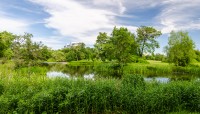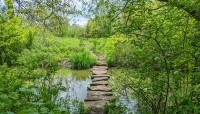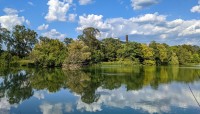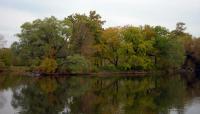Landscape Information
This 367-acre, rectangular park was designed by Olmsted, Vaux & Co. in 1870 as part of the 1,055-acre South Park System and is linked to Jackson Park via the Midway Plaisance. Located one mile inland from Lake Michigan, the flat, prairie terrain was transformed into a two-part park. The north end of the site—the South Opera Green, which is a large, pastoral meadow originally grazed by sheep—provides a mile-long, uninterrupted view of open parkland. Groves of shade trees enclose the meadow and add vertical interest to the prairie’s horizontality. In the south, an expansive meer was excavated and punctuated with simple footbridges that span the Picturesque pond at its most narrow points. The excavated soil was recycled as a perimeter berm, running along the park’s eastern boundary, echoing a similar glacial ridge on the western side. Construction began in 1872 and was overseen by landscape gardener H.W.S. Cleveland, and in 1881 the park was renamed in honor of President George Washington. In the 1880s, architect Daniel H. Burnham designed the limestone refectory and round stables and, in 1910, added the South Park Commission administrative headquarters (now the DuSable Black History Museum and Education Center).
During the Great Migration, when southern African Americans relocated to northern cities, the neighborhood surrounding the park was incorporated into the city’s “Black Belt.” Though never formally segregated, by the late 1920s African Americans constituted the majority of the park’s visitors.
Sculptor Lorado Taft’s Fountain of Time (1922), an expansive concrete composition oriented around a reflecting pool, is the hinge that links Washington Park to the Midway Plaisance.
Washington Park is a contributing feature of the Historic Resources of the Chicago Park District listed in the National Register of Historic Places in 1990 and the Chicago Park Boulevard System Historic District listed in 2018. It was listed individually in 2004.


















